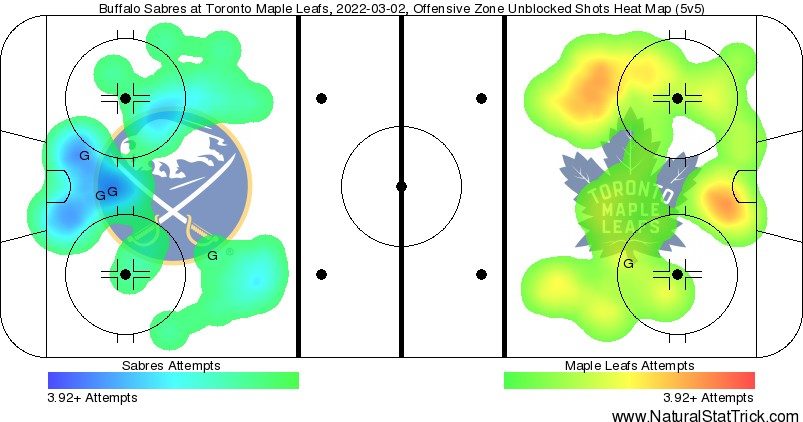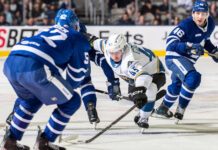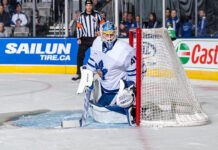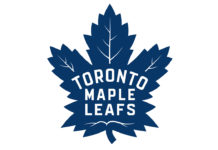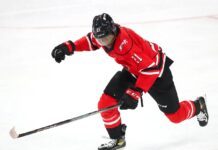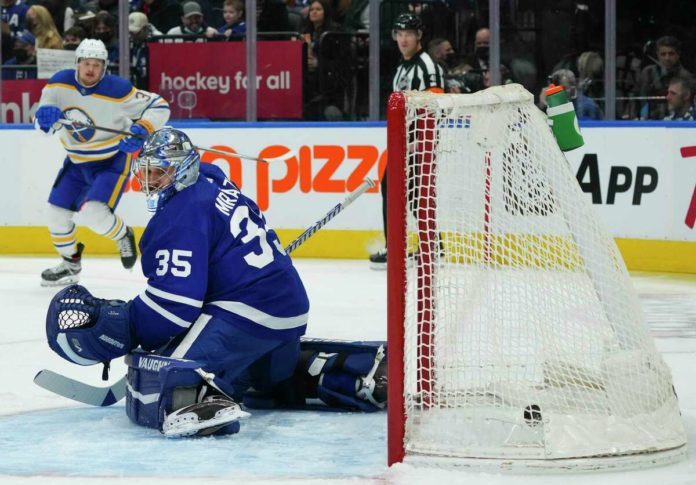
On a night when the fans filled Scotiabank Arena to capacity for the first time in several months, a game against a badly-slumping Sabres squad ended in boos and jeers.
The Maple Leafs were listless and unenthusiastic on Wednesday night during a 5-1 defeat to Buffalo. This was a poor showing from every position group in the lineup. Toronto conceded goals in every period, extended their power-play drought, and brought no certainty to a goaltending situation that remains the biggest question mark on the team.
Your game in 10:
1. While the Leafs did not get good goaltending (more on that later), this was a putrid team effort regardless of the netminding performance. The Sabres were the better team tonight, especially after the halfway point of the contest. Buffalo owned 60% of the scoring chances, 64.71% of the high-danger chances, and 55.3% of the expected goals at 5v5, per Natural Stat Trick. They played more disciplined and effective defense, showed more energy up and down the ice, and capitalized on the chances they generated.
Only one line and one defensive pair made it out with positive impacts at even strength as the Leafs were soundly beaten by a team that was simply better on this night. This was not a fluke.
Sheldon Keefe summed it up succinctly in his post-game comments:
Keefe’s assessment: “It was terrible from start to finish.”
— David Alter (@dalter) March 3, 2022
2. The one forward line that did grade out well happens to be the line I was most interested in watching: the Pierre Engvall, David Kampf, and Ilya Mikheyev unit. Those three put up sterling metrics against the Capitals and passed the eye test on Monday, and they did the same tonight.
Kampf happened to be on the ice during one poor defensive sequence where a goal was allowed (in the midst of a change), dropping his xGF% below his linemates, but all three were good compared to the listlessness of their teammates. This line continues to flash its speed and defensive prowess, and they make the opposition’s defense work when they go on the forecheck.
Engvall led Toronto with five shots on goal and had two glorious chances on an abbreviated breakaway set up by a fabulous pass from Mikheyev in the second period. I hope Sheldon Keefe keeps this line intact; their last two outings have been promising indications of their prowess as a checking line.
Anderson robs Engvall pic.twitter.com/wVmW3XdqQr
— Omar (@TicTacTOmar) March 3, 2022
3. After we started to see signs of life from the scuffling second line on Monday, this game was a hard fall right back on the schneid. John Tavares and William Nylander were virtually invisible in the offensive zone, unable to drive play nor create chances with any consistency.
The motivated, assertive Tavares we saw in the heroic closing minutes against the Capitals was nowhere to be found at Scotiabank Arena against the Sabres. Alex Kerfoot did have a scoring chance that he was unable to redirect in off a great pass from Rasmus Sandin, but otherwise, it was not his most memorable performance.
Perhaps the most notable development from this group came late in the contest when we saw Nick Robertson jump up to the second line and skate with Tavares and Nylander briefly. It will be interesting to see if that was merely garbage time tinkering from Keefe or the start of a new experiment. Obviously, the health of Ondrej Kaše moving forward will play a determining role in that.
4. Speaking of experiments, the new-look defensive pairings were an adventure.
Let’s start with the top pair of Morgan Rielly and Rasmus Sandin. The two have some attributes that click together, but Rielly has never been known as a defensive defenseman, and there ought to be sizable questions about whether Sandin can bring the defensive presence needed to balance out the pair after tonight’s performance.
Things started off pretty well for the two, generating a goal in conjunction with the top line that Sandin finished off for his first goal at Scotiabank Arena as a Maple Leaf. Then it all went haywire. Sandin committed a defensive zone turnover in front of his own net but recovered okay to block the shot. Turns out that was a bad omen for developments to come.
The pairing was on the ice for each of the next three goals against, with the subsequent two following similar patterns: Rielly drifting away from the action and Sandin struggling against pressure in front of the net. Sandin lost positioning near the crease before a rebound on the second Buffalo goal and then appeared to overhandle a loose puck in the slot that was poked free and quickly converted by Tage Thompson. Playing on his off-side, he also awkwardly botched a D-to-D pass reception in the neutral zone leading to Jeff Skinner’s 4-1 goal.
Tage Thompson. 3-1 pic.twitter.com/qP1Vaz6vZP
— Omar (@TicTacTOmar) March 3, 2022
I never want to make definitive proclamations after a one-game sample, but the concerns about what a Rielly-Sandin pairing would look like were borne out very clearly in this game. Their SCF% and xGF% numbers aren’t as bad as you’d think when you surrender three goals at 5v5 (grading out in the mid-30% range) in part due to poor goaltending and also some positive offensive moments, but the eye test was pretty harshly negative.
For what it’s worth, it sounds like this may just be a one-game trial pairing given what Keefe said after the game:
Would you consider going back to the Rielly-Sandin pairing to give it a longer look?
Keefe: “Probably not.”
5. On that note, I’m continually intrigued by the willingness of a coaching staff to experiment and shake things up. I am generally of the mindset that Sheldon Keefe should use the regular season to get a feel for which pairings work the best given how fleeting the postseason is. There is little margin for error, and I’d prefer the team enter the playoffs knowing exactly what their best defensive configurations are, something that’s become even more unclear with the addition of Ilya Lubushkin and the injury to Jake Muzzin.
I’m all for Keefe trying things out, and if the options are between entering the playoffs still leaning on the old standbys that may not be optimal while pushing hard for a division title, or finishing second/third in the Atlantic but entering the playoffs with a better understanding of the right defensive combinations, I’d take the latter.
Experimenting with new ideas is sometimes going to lead to turbulence, and the whole team shares the blame for this ugly result; not just the Rielly-Sandin pairing.
6. The top line had one of its worst efforts of the season tonight. Mitch Marner and Michael Bunting orchestrated a pretty give-and-go to set up Rasmus Sandin for a goal in the first period, but it was pretty much a bust after that.
RASMUS SANDIN 🚨
1ST HOME GOAL! WHAT A PLAY! pic.twitter.com/z7LmA9sLtd
— Omar (@TicTacTOmar) March 3, 2022
Auston Matthews had his second straight game without a goal and was uncharacteristically hard to spot on the ice. He finished with three shots on goal, but his most noticeable moment came when his stick shattered in pieces on a one-time attempt on the lone Leafs power play, which one could interpret as a microcosm of the whole game.
Marner did show up again late with a nice steal and set up for Ilya Mikheyev on the penalty kill with under five minutes to go, but the game was well out of hand by that point. He also got his stick on the puck that nearly prevented the second goal (unfortunately, it resulted in a bad bounce that arguably made that chance more dangerous), but Marner was the only one of these three that had more than one memorable moment.
It’s never a good sign when you say that about your top line! Given how this line has wrecked team after team prior to the Sabres, it’s much more likely that this was a bummer off-night for the top line than anything too concerning.
7. Well, Petr Mrazek didn’t do much to calm the critics down, did he? Evolving Hockey’s numbers had him finishing at a grisly -2.65 goals saved above expected for the contest, and it’s now his second time in the last five outings that he’s allowed five goals.
I think the GSAx number is a bit unfair; the first goal will register as a howler, but it did take a tough redirect off of Morgan Rielly‘s knee. There were also defensive breakdowns on every other goal scored by the Sabres.
That said, Mrazek was not good tonight. He didn’t come up with a save on the Jeff Skinner breakaway to make it 4-1 when Toronto really needed him to. The Leafs‘ play resembling a lifeless carcass didn’t portend well for the possibility of a comeback at that point, but a Mrazek save in that situation at least keeps the team within shouting distance with 13 minutes to play. Didn’t happen.
Jeff Skinner. 4-1 pic.twitter.com/gBH8sU4Tpc
— Omar (@TicTacTOmar) March 3, 2022
I’m not sure where the Leafs go from here in net. There was plenty of talk over the last couple of days about how Keefe needed to finally admit Mrazek is playing better and ride him. In his first opportunity to start a second consecutive game, Mrazek posted an .839 SV%.
I guess you go back to Jack Campbell on Saturday night? I think the best approach at this point is to ask this question: “Did our goalie play average or better tonight?” If the answer is yes, start him again. If not, go back to the other guy.
8. The Maple Leafs looked a step slow in this game, especially as it wore on, seemingly showing signs of fatigue. It was a rather peculiar performance considering Toronto had a day off prior to it and isn’t in the midst of a heavily condensed stretch of games, either.
Around the halfway point of the contest, it was still 1-1 and the chances were close to even. Not great, considering who you’re playing, but it was also not the worst-case scenario… that came in the back half of the game. But even throughout the whole game, the forecheck didn’t have the same energy or bite it normally does, and the numbers back it up:
Buffalo had the best zone exit success against the Leafs of any opponent in their last 10 games, which matched the ol eye test. 83.3% of Buffalo’s attempted exits were successful. TO normally a good forechecking team, simply weren’t tonight, just didn’t seem to have their legs.
— Justin Bourne (@jtbourne) March 3, 2022
Once the latter half of the game rolled around, the Maple Leaf defense was lethargic and the forwards had no response to push back, outside of the Pierre Engvall chance shortly after the second Buffalo goal. Maybe if he converts on that one the team snaps awake, but by the time the third period rolled around, the Leafs seemed like they were mentally and physically checked out.
The final goal allowed, where the forwards didn’t bother to backcheck and Brodie-Holl were beaten cleanly, was just pathetic.
9. We should also give credit to the Sabres for very strong play in their defensive zone to take away the middle of the ice and guard the high-danger areas. The Leafs won the shot-attempt battle — a CF% of 55.21% and a FF% of 54.67% — and they held possession of the puck in the offensive zone for longer than the Sabres did. Yet all that possession time and all of those shot attempts didn’t translate into scoring chances.
The Leafs occasionally got a look around the net, but the shot maps show that their play was pushed to the perimeter. The Sabres took away shooting lanes well and this was a night when Toronto was going to need to bully their way more and put pressure on a still-creaky Sabres defense. Due to the low energy level I mentioned in the preceding point, that never materialized.
10. Let’s not act like the Leafs were the only sleepy people in the building, either. The fans were comatose, offering no energy to try and lift up their struggling troops. Yes, the game was a snoozer until the halfway point as the Sabres trapped the Maple Leafs into low-event hockey, but I really hoped to see more enthusiasm from the audience given that it was the first game back to full capacity since December. The listed attendance was 17,122, but it sounded more like 1,722, which was pretty disappointing.
Game Flow: 5v5 Shot Attempts
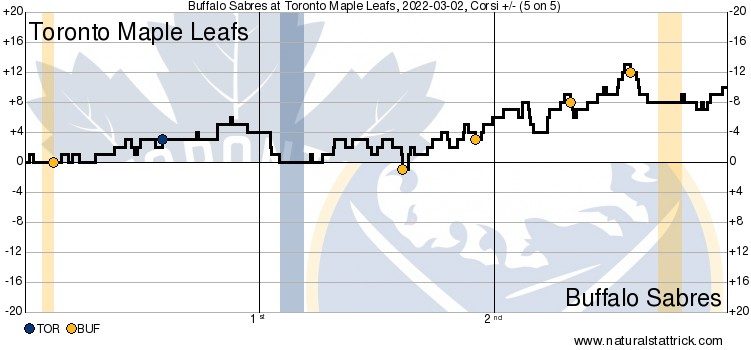
Heat Map: 5v5 Shot Attempts
